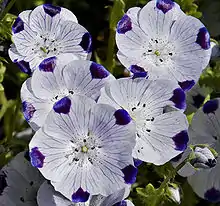Nemophila maculata
Nemophila maculata, with common names fivespot, is a species of flowering plant in the borage family (Boraginaceae).
| Nemophila maculata | |
|---|---|
 | |
| Scientific classification | |
| Kingdom: | Plantae |
| Clade: | Tracheophytes |
| Clade: | Angiosperms |
| Clade: | Eudicots |
| Clade: | Asterids |
| Order: | Boraginales |
| Family: | Boraginaceae |
| Genus: | Nemophila |
| Species: | N. maculata |
| Binomial name | |
| Nemophila maculata | |
Distribution
The wildflower is found on slopes in elevations between 20–1,000 metres (66–3,281 ft). It is most common in the Sierra Nevada, Sacramento Valley, and the California Coast Ranges in the San Francisco Bay Area.
It is found in several plant communities, including valley grassland, foothill woodland, and pine and fir forest.[1]
Description
Nemophila maculata is an annual herb that flowers in the spring. The leaves are up to 3 centimeters long and 1.5 wide, and are divided into several smooth or toothed lobes.[2]
The flowers are bowl-shaped, white with dark veins and dots. The lobe tips are purple-spotted. The corolla is 1 to 2 centimeters long and up to 5 centimeters wide. The flowers' spots, giving the common name fivespot, attracts its primary pollinators, which are solitary bees. Male and female bees feed on the nectar and females collect pollen to feed their larvae.[2]
The seeds are greenish-brown and are smooth or shallowly pitted. The fruit produces up to 12 seeds. The entire fruiting and seed cycle begins in spring and ends in the summer.[2]
Cultivation
Nemophila maculata is sown as an annual ornamental plant in traditional, native plant, and pollinator/wildlife gardens.
References
- Jepson (TJM2)
- California Academy of Sciences, California Wildflowers: Nemophila maculata
External links
- Calflora Database: Nemophila maculata (baby blue eyes)
- Jepson Flora Project (1993): Nemophila maculata
- Nemophila maculata — UC Photos gallery
| Wikimedia Commons has media related to Nemophila maculata. |